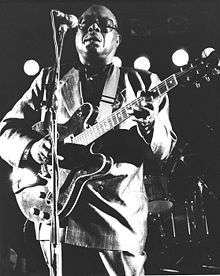Jimmy Rogers
Jimmy Rogers (June 3, 1924 – December 19, 1997)[2] was a Chicago blues singer, guitarist and harmonica player,[1] best known for his work as a member of Muddy Waters's band in the early 1950s.[3] He also had solo hits on the R&B chart with "That's All Right" in 1950 and "Walking by Myself" in 1954. He withdrew from the music industry at the end of the 1950s but returned to recording and touring in the 1970s.
Jimmy Rogers | |
|---|---|
 Rogers in concert | |
| Background information | |
| Birth name | Jay Arthur Lane |
| Born | June 3, 1924 Ruleville, Mississippi, U.S. |
| Died | December 19, 1997 (aged 73) Chicago, Illinois, U.S. |
| Genres | Chicago blues[1] |
| Occupation(s) | Musician |
| Instruments | |
| Years active | 1946–1997 |
| Labels | Chess |
| Associated acts | |
He is not to be confused with the country music singer Jimmie Rodgers or the pop singer Jimmie Rodgers.
Career
Rogers was born Jay Arthur Lane in Ruleville, Mississippi,[4] on June 3, 1924. He was raised in Atlanta and Memphis.[5] He adopted his stepfather's surname.[3] He learned to play the harmonica with his childhood friend Snooky Pryor, and as a teenager he took up the guitar. He played professionally in East St. Louis, Illinois, with Robert Lockwood, Jr., among others.[6] Rogers moved to Chicago in the mid-1940s.[7] By 1946, he had recorded as a harmonica player and singer for the Harlem record label, run by J. Mayo Williams. Rogers's name did not appear on the record, which was mislabeled as the work of Memphis Slim and His Houserockers.
In 1947, Rogers, Muddy Waters and Little Walter began playing together, forming Waters's first band in Chicago[8] (sometimes referred to as the Headcutters or the Headhunters, because of their practice of stealing jobs from other local bands).[9] The band members recorded and released music credited to each of them as solo artists. The band defined the sound of the nascent Chicago blues style (more specifically, South Side Chicago blues). Rogers recorded several sides of his own with small labels in Chicago, but none were released at the time. He began to achieve success as a solo artist in 1950, with the hit song "That's All Right", released by Chess Records, but he stayed in Waters's band until 1954.[3] In the mid-1950s he had several successful records released by Chess, most of them featuring either Little Walter or Big Walter Horton on harmonica, notably "Walking by Myself".[10] In the late 1950s, as interest in the blues waned, he gradually withdrew from the music industry.[3]
In the early 1960s, Rogers briefly worked as a member of Howling Wolf's band, before quitting the music business altogether for almost a decade. He worked as a taxicab driver and owned a clothing store, which burned down in the 1968 Chicago riots following the assassination of Martin Luther King, Jr. Rogers gradually began performing in public again, and in 1971, when fashions made him somewhat popular in Europe, he began occasionally touring and recording, including a 1977 session with Waters which resulted in the album I'm Ready. By 1982, Rogers was again a full-time solo artist. He owned and drove a white 1965 Ford Mustang Convertible which he eventually sold. He continued touring and recording albums until his death.
He was inducted into the Blues Hall of Fame in 1995.[11]
Rogers died of colon cancer in Chicago in 1997.[2] He was survived by his son, Jimmy D. Lane, a guitarist, record producer and recording engineer for Blue Heaven Studios and APO Records.
On June 25, 2019, The New York Times Magazine listed Jimmy Rogers among hundreds of artists whose material was reportedly destroyed in the 2008 Universal fire.[12]
Selected discography
- Jimmy Rogers (1984), compilation album of some pre-1960 songs
- Ludella (1990)[13]
- Jimmy Rogers with Ronnie Earl and the Broadcasters (1991), live recording
- Feelin' Good, with Rod Piazza (1994, Blind Pig)
- Sloppy Drunk (1998), compact disc reissue of the album released in December 1973
- Blue Bird (1994, Analogue Productions Originals)
- The Complete Chess Recordings (1997)[14]
- Blues Blues Blues, as the Jimmy Rogers All-Stars, with Mick Jagger, Keith Richards, Eric Clapton, Taj Mahal, Lowell Fulson, Jimmy Page, Robert Plant, Jeff Healey and others (1999)
With Sunnyland Slim
- House Rent Party (Delmark, 1947 [1992])
With Muddy Waters
- The Real Folk Blues (Chess, 1948–54, [1966])
- More Real Folk Blues (Chess, 1950-53 [1967])
References
- Du Noyer, Paul (2003). The Illustrated Encyclopedia of Music. Fulham, London: Flame Tree Publishing. p. 181. ISBN 1-904041-96-5.
- Doc Rock. "The Dead Rock Stars Club 1996–1997". Thedeadrockstarsclub.com. Retrieved 2015-08-30.
- Russell, Tony (1997). The Blues: From Robert Johnson to Robert Cray. Dubai: Carlton Books. p. 161. ISBN 1-85868-255-X.
- Eagle, Bob; LeBlanc, Eric S. (2013). Blues: A Regional Experience. Santa Barbara, California: Praeger. p. 196. ISBN 978-0313344237.
- Harris, S. (1979). Blues Who's Who. New York: Da Capo Press. p. 442.
- Robert Palmer. Deep Blues. Penguin Books. p. 200. ISBN 978-0-14-006223-6.
- Gordon, Robert (2002). Can't Be Satisfied: The Life and Times of Muddy Waters. Boston: Little, Brown. p. 74. ISBN 0-316-32849-9.
- Robert Palmer. Deep Blues. Penguin Books. p. 15. ISBN 978-0-14-006223-6.
- Robert Palmer. Deep Blues. Penguin Books. p. 208. ISBN 978-0-14-006223-6.
- Dahl, Bill. "Good Rockin' Charles". AllMusic.com. Retrieved November 23, 2011.
- "Blues Foundation: Inductees". Blues.org. Archived from the original on February 10, 2009. Retrieved October 27, 2008.
- Rosen, Jody (25 June 2019). "Here Are Hundreds More Artists Whose Tapes Were Destroyed in the UMG Fire". The New York Times. Retrieved 28 June 2019.
- Archived November 9, 2006, at the Wayback Machine
- "The Complete Chess Recordings: Jimmy Rogers: MP3 Downloads". Amazon.com. Retrieved 2015-08-30.